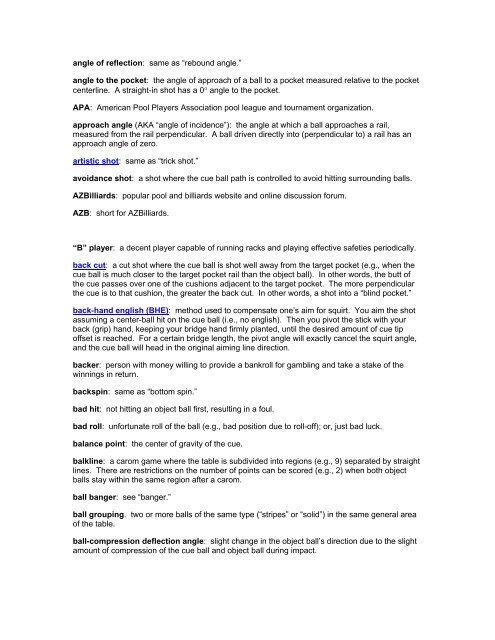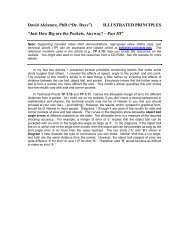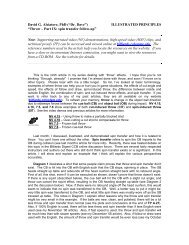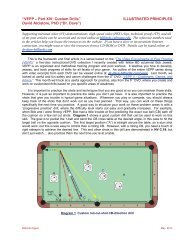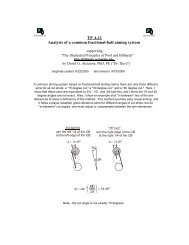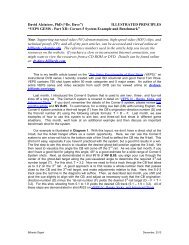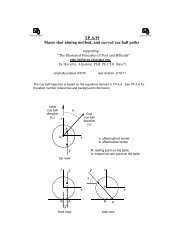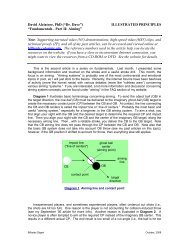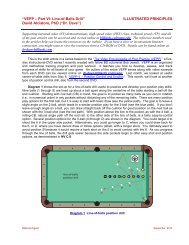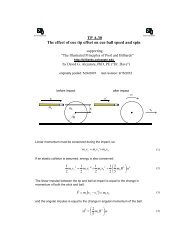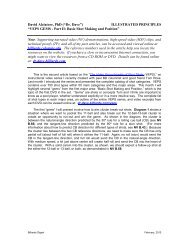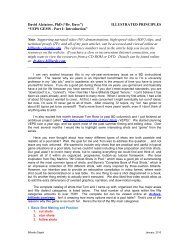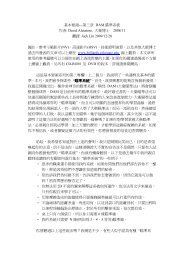Expanded Glossary from the book - Illustrated Principles of Pool and ...
Expanded Glossary from the book - Illustrated Principles of Pool and ...
Expanded Glossary from the book - Illustrated Principles of Pool and ...
Create successful ePaper yourself
Turn your PDF publications into a flip-book with our unique Google optimized e-Paper software.
angle <strong>of</strong> reflection: same as “rebound angle.”<br />
angle to <strong>the</strong> pocket: <strong>the</strong> angle <strong>of</strong> approach <strong>of</strong> a ball to a pocket measured relative to <strong>the</strong> pocket<br />
centerline. A straight-in shot has a 0 angle to <strong>the</strong> pocket.<br />
APA: American <strong>Pool</strong> Players Association pool league <strong>and</strong> tournament organization.<br />
approach angle (AKA “angle <strong>of</strong> incidence”): <strong>the</strong> angle at which a ball approaches a rail,<br />
measured <strong>from</strong> <strong>the</strong> rail perpendicular. A ball driven directly into (perpendicular to) a rail has an<br />
approach angle <strong>of</strong> zero.<br />
artistic shot: same as “trick shot.”<br />
avoidance shot: a shot where <strong>the</strong> cue ball path is controlled to avoid hitting surrounding balls.<br />
AZBilliards: popular pool <strong>and</strong> billiards website <strong>and</strong> online discussion forum.<br />
AZB: short for AZBilliards.<br />
“B” player: a decent player capable <strong>of</strong> running racks <strong>and</strong> playing effective safeties periodically.<br />
back cut: a cut shot where <strong>the</strong> cue ball is shot well away <strong>from</strong> <strong>the</strong> target pocket (e.g., when <strong>the</strong><br />
cue ball is much closer to <strong>the</strong> target pocket rail than <strong>the</strong> object ball). In o<strong>the</strong>r words, <strong>the</strong> butt <strong>of</strong><br />
<strong>the</strong> cue passes over one <strong>of</strong> <strong>the</strong> cushions adjacent to <strong>the</strong> target pocket. The more perpendicular<br />
<strong>the</strong> cue is to that cushion, <strong>the</strong> greater <strong>the</strong> back cut. In o<strong>the</strong>r words, a shot into a “blind pocket.”<br />
back-h<strong>and</strong> english (BHE): method used to compensate one’s aim for squirt. You aim <strong>the</strong> shot<br />
assuming a center-ball hit on <strong>the</strong> cue ball (i.e., no english). Then you pivot <strong>the</strong> stick with your<br />
back (grip) h<strong>and</strong>, keeping your bridge h<strong>and</strong> firmly planted, until <strong>the</strong> desired amount <strong>of</strong> cue tip<br />
<strong>of</strong>fset is reached. For a certain bridge length, <strong>the</strong> pivot angle will exactly cancel <strong>the</strong> squirt angle,<br />
<strong>and</strong> <strong>the</strong> cue ball will head in <strong>the</strong> original aiming line direction.<br />
backer: person with money willing to provide a bankroll for gambling <strong>and</strong> take a stake <strong>of</strong> <strong>the</strong><br />
winnings in return.<br />
backspin: same as “bottom spin.”<br />
bad hit: not hitting an object ball first, resulting in a foul.<br />
bad roll: unfortunate roll <strong>of</strong> <strong>the</strong> ball (e.g., bad position due to roll-<strong>of</strong>f); or, just bad luck.<br />
balance point: <strong>the</strong> center <strong>of</strong> gravity <strong>of</strong> <strong>the</strong> cue.<br />
balkline: a carom game where <strong>the</strong> table is subdivided into regions (e.g., 9) separated by straight<br />
lines. There are restrictions on <strong>the</strong> number <strong>of</strong> points can be scored (e.g., 2) when both object<br />
balls stay within <strong>the</strong> same region after a carom.<br />
ball banger: see “banger.”<br />
ball grouping. two or more balls <strong>of</strong> <strong>the</strong> same type (“stripes” or “solid”) in <strong>the</strong> same general area<br />
<strong>of</strong> <strong>the</strong> table.<br />
ball-compression deflection angle: slight change in <strong>the</strong> object ball’s direction due to <strong>the</strong> slight<br />
amount <strong>of</strong> compression <strong>of</strong> <strong>the</strong> cue ball <strong>and</strong> object ball during impact.


